 |
|
|
|
|
|
|
|
|
|
|
|
|
|
|
|
|
|
|
|
|
|
|
|
|
|
|
|
|
|
|
|
|
|
|
|
|
|
|
MARINE AQUARIUM SOCIETY OF TORONTO
Hard & Soft Coral Propagation Workshop
February 10, 1999 |
|
|
|
This is not an official site of MAST, nor has
this article been authorized by MAST. |
|
|
|
A coral propagation workshop was held on the Feb 10th MAST meeting. The large turnout of interested members were not disappointed. Ron Mascarin, our vice-president, purchased a number of damaged and unsellable corals from a local wholesaler. Fragmenting and propagating these corals that would have otherwise died is an environmentally sound decision and one that should be encouraged. Such activities are one of the many benefits of club membership. |
|
|
|
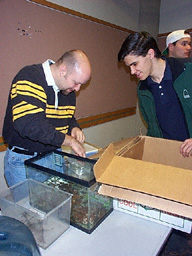 |
|
|
|
Ron (l) and society member Bryan Reid assess the "catch of the day" and place them in the holding tank in preparation for the evening's activities. |
|
|
|
|
|
In his preamble Ron pointed out that by utilizing the clonal properties of corals we can propagate many of them. The overwhelming benefit to this activity is a reduced impact upon natural reefs. There is some validity to the claim that fragments of captive corals do better in aquaria than wild caught corals. It should also be noted that the smaller fragments transport much better than colonies. If possible, insist on purchasing aquacultured fragments. They have a much better survival rate and it will give there is much pleasure to be derived from observing the coral grow from a small fragment. |
|
|
|
The corals we had for the workshop included the branching SPS Montipora, Hydnofora and Pocillopora, an algae covered gorgonian, a leather coral and a colt coral.
The fragmentation technique used for each type of coral will depend upon the coral and the properties it exhibits.
The sps corals are usually fragmented through the use of plyers, though dental tools can prove more useful in certain instances. The soft corals are easily cut with a sharp razor blade.
|
|
|
|
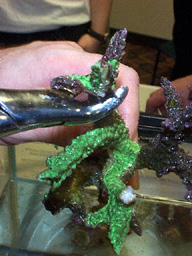 |
|
|
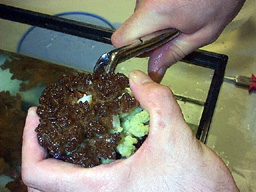 |
|
|
|
|
|
|
Ron demonstrates the finer points of pulling teeth, umm, er fragmenting sps corals |
|
|
|
The method of attachment varies greatly and depends upon the type of coral that is to be propagated. Marine epoxy, superglue and mechanical means are the most frequently recommended methods of fragment attachment.
Branching SPS:
Montipora, a fragile sps can be easily broken and attached to a rock using marine epoxy. The epoxy comes in a roll with two distinct components. Using a razor blade or scissors cut enough epoxy for the fragment to be attached. The material must be kneaded together to produce a uniformly coloured mixture. The epoxy will be ready to use when you can feel the chemical heat produced by mixing. |
|
|
|
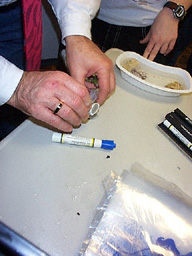 |
|
|
|
Marine epoxy is being cut using a razor blade. Notice the hospital tray for holding frags as well as the supply of plastic bags for transporting the coral frags. |
|
|
|
|
|
Once the epoxy is thoroughly mixed it has to be applied to a rock. Live rock was chiseled to produce a good supply of suitable attachment bases. The epoxy is placed onto the rock and pressed down firmly to provide good adhesion. There is something to be said for using rough, porous rocks. An attempt should be made to form a mountain of epoxy. |
|
|
|
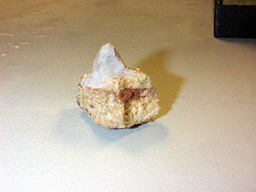 |
|
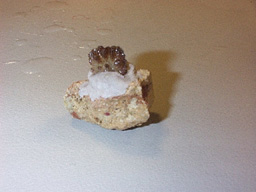 |
|
|
Ensure that the epoxy is securely attached to the base rock before proceeding to attach the coral fragment. The fragment can be pressed into the cone to complete the process.
|
|
|
|
When you are certain that the epoxy is going to adhere to the rock the coral fragment can be pressed into the peak of the cone. Model the epoxy tightly around the base of the fragment and ensure that the frag is secure. There is no need to rush during this process. The epoxy can be manipulated for up to five minutes and the coral will remain wet and viable for as long as five to ten minutes. If there is any concern for the coral it can be dipped in saltwater or sprayed occasionally. |
|
|
|
Proceed to Soft Coral Propagation (page 2) |
|





